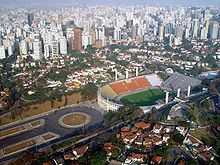Pacaembu Stadium
| Pacaembu | |
 | |
| Full name | Estádio Municipal Paulo Machado de Carvalho |
|---|---|
| Location | São Paulo, SP, Brazil |
| Coordinates | 23°32′55.1″S, 46°39′54.4″W |
| Owner | City of São Paulo |
| Operator | Secretaria Municipal de Esportes |
| Capacity | 37,730 |
| Field size | 104 x 70 m |
| Surface | Natural grass |
| Construction | |
| Built | September 17, 1938 |
| Opened | April 27, 1940 |
| Renovated | 2007 |
| Expanded | 1958 and 1970 |
| Architect | Escritório Técnico Ramos de Azevedo - Severo e Villares[1] |
Estádio Municipal Paulo Machado de Carvalho, colloquially known as Estádio do Pacaembu (Portuguese pronunciation: [isˈtadʒiu du pakaẽˈbu]) is a football stadium in São Paulo, located in the Pacaembu neighborhood. The stadium is owned by the Municipal Prefecture of São Paulo. The stadium was inaugurated on April 27, 1940, in the presence of the Brazilian President Getúlio Vargas, the intervener Adhemar de Barros and the mayor of São Paulo Prestes Maia. The stadium holds 37,952 people and its pitch dimensions are 104 m of length by 70 m of width.
The stadium is named after Paulo Machado de Carvalho. He was the 1958 FIFA World Cup Brazilian delegation chief, the founder of Rede Record, one of the largest television networks in Brazil and was known as "Marechal da Vitória" (Marshal of Victory).
History


The first match ever played at Pacaembu Stadium took place on April 27, 1940, when Palestra Itália (Palestra Itália was Palmeiras' original name) and Coritiba. Palestra Itália beat Coritiba 6-2. The first goal of the stadium was scored by Coritiba's Zequinha. After this match, another match was played, where Corinthians beat Atlético Mineiro 4-2. Both matches were from Taça Cidade de São Paulo's cup. Corinthians played many of their home matches at Pacaembu until the opening of Arena Corinthians in 2014.
On May 4, 1940, the Taça Cidade de São Paulo Final was played. Palestra Itália beat Corinthians 2-1, being the first club to win a competition at Pacaembu Stadium.
The stadium's attendance record currently stands at 71,281 people, set on May 24, 1942 when Corinthians and São Paulo drew 3-3.
On September 20, 1942, Palmeiras played its first match after changing its name (the previous name was Palestra Itália). Palmeiras beat São Paulo 3-1, winning that year's Campeonato Paulista.
In 1945, the stadium's largest score was set, when São Paulo beat Jabaquara 12-1.
In 2005, the stadium served as the first pit-stop of The Amazing Race 9.
On May 11, 2007, the pope Benedict XVI met with the youth of Brazil as a part of his Apostolic Journey to Brazil on the occasion of the Fifth General Conference of the Bishops of Latin America and the Caribbean.
Between July 2010 to November 2014, the stadium was the temporary home ground of Palmeiras since their stadium closed for reformish until the reopen as Allianz Parque.
1950 FIFA World Cup
Several 1950 FIFA World Cup matches were played at Estádio do Pacaembu, which were:
| Date | Time | Team #1 | Res. | Team #2 | Round | Spectators |
|---|---|---|---|---|---|---|
| 1950-06-25 | 15.00 | 3–2 | Group 3 | ~50,000 | ||
| 1950-06-28 | 15.00 | 2–2 | Group 1 | ~42,000 | ||
| 1950-07-02 | 15.00 | 2–0 | Group 3 | ~26,000 | ||
| 1950-07-09 | 15.00 | 2–2 | Final Round | ~44,000 | ||
| 1950-07-13 | 15.00 | 3–2 | Final Round | ~8,000 | ||
| 1950-07-16 | 15.00 | 3–1 | Final Round | ~11,000 |
Concerts
- Paul McCartney performed in front of 45,000 fans in 1993, during his New World Tour.
- On January 27, 28 and 30, 1995, the Rolling Stones performed three sold-out concerts at Pacaembu, to a total audience of 170,000 people.
- The Red Hot Chili Peppers performed at the stadium in 2002 on their By The Way Tour.
- Avril Lavigne's 2005 Bonez Tour made a stop here, in front of 40,000 fans.
- Brazilian singer Roberto Carlos performed at the stadium in a 2001 concert.
- Heavy metal band Iron Maiden has made two stops at the venue: in 1996 and 2004.
Museum

On September 29, 2008, the Museu do Futebol (Museum of Football) was inaugurated.[2] It was created to tell the history of Brazilian football.[3] The museum covers 6,900 square metres (1.7 acres), it was built at a cost of R$32.5 millions, and is located below the stadium's bleachers.[4] The 680 workers hired to build the museum completed the construction in 13 months.[5]
References
- ↑ "About the architecture project" (in Portuguese). São Paulo State Government.
- ↑ "Museu do Futebol é inaugurado nesta segunda-feira em São Paulo" (in Portuguese). Correio da Bahia. 2008-09-29. Retrieved 2008-09-28.
- ↑ "Visitar o Museu do Futebol custará R$ 6" (in Portuguese). Globo Esporte. 2008-09-23. Retrieved 2008-09-28.
- ↑ "São Paulo inaugura Museu do Futebol" (in Portuguese). São Paulo state government. 2008-09-29. Retrieved 2008-09-29.
- ↑ "Museum honours Brazilian history". FIFA. 2008-09-30. Retrieved 2008-10-03.
- Enciclopédia do Futebol Brasileiro, Volume 2 - Lance, Rio de Janeiro: Aretê Editorial S/A, 2001.
External links
Coordinates: 23°32′55.1″S 46°39′54.4″W / 23.548639°S 46.665111°W
| ||||||
| ||||||
| ||||||
| ||||||
| ||||||||||||||||||||||||||||||